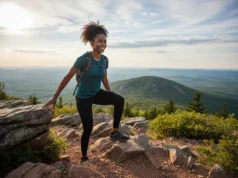In this article
Choosing the right hiking shorts can feel overwhelming. You’re faced with a wall of technical jargon, a dizzying array of features, and the ever-present risk of making a choice that leads to misery on the trail—from the nagging burn of chafing to the critical failure of a key piece of gear miles from the trailhead.
We cut through that noise. You’ll learn to understand the key fabric and design technologies that actually matter for performance, be equipped with a clear decision framework to evaluate any pair of hiking shorts, and confidently select the perfect pair optimized for your specific hikes, whether you’re a casual adventurer, a technical scrambler, or a long-distance backpacker.
Understanding the Fundamentals: What Truly Matters in a Hiking Shorts Men?
To make a smart choice, you first need the essential knowledge to decode product features. Let’s turn you into an expert on your own gear needs.
Why Are Material and Fabric Properties the Most Critical Choice?
The fabric of your shorts is the foundation of their performance, dictating their durability, comfort, and weather resistance. The primary choice is between Nylon and Polyester. Nylon offers superior durability and abrasion resistance, making it the ideal candidate for trails that involve scraping against rock or pushing through dense brush on rugged mountain terrain. Polyester, on the other hand, is more hydrophobic, meaning it repels water, dries significantly faster, and excels in wet climates or during high-sweat outdoor activities. A critical component in modern men’s hiking shorts is a stretch material like Spandex or Elastane.
Even a small percentage, typically between 4-15%, is non-negotiable for mobility, allowing the fabric to move with you during high steps and scrambles. For protection against the elements, a DWR (Durable Water Repellent) finish is a chemical coating that causes water to bead up and roll off the surface. This provides essential water resistance for shedding light rain or morning dew, helping you dry faster, much like the technology used in the best waterproof rain jackets. Finally, for exposed trails and high-altitude treks, sun protection is a vital safety feature. An UPF (Ultraviolet Protection Factor) rating measures this protection, and according to guidance from The Skin Cancer Foundation, a rating of UPF 50+ is the gold standard, blocking over 98% of harmful UV rays.
How Does Design and Fit Prevent Chafing and Improve Mobility?
A perfect fabric means nothing if the short’s design works against you. The most common on-trail ailment is the chafing problem—a painful friction burn caused by fabric-on-skin or skin-on-skin rubbing, exacerbated by moisture and sweat, particularly on the thigh. Indeed, a study on long-distance backpackers published by the National Library of Medicine found skin irritation affects up to 51% of hikers, making its prevention a critical design goal. The single most important design feature for both comfort and mobility is a gusseted crotch. This diamond-shaped panel sewn into the inseam replaces a traditional four-way seam junction, a major friction point, while dramatically increasing durability and range of motion.
The type of seam construction also matters; look for flatlock seams, which lie flat against the skin and are far less likely to cause irritation than traditional raised seams. The short’s waistband is another key consideration, especially for backpackers. The choice between an integrated hiking belt, a simple drawstring, or traditional belt loops directly impacts comfort under a backpack’s hipbelt. A flat waistband or other low-profile systems that don’t bunch or create pressure points are vastly superior for preventing rubbing over long miles. This is a key differentiator from standard cotton cargo shorts, which often have bulky belt loops that create painful hot spots under a backpack. Ultimately, these principles of mobility and comfort are equally important in our guide to men’s hiking pants.
The Bridge: How We Tested and What We Looked For
Now that you’re armed with the theory, we’ll explain how we applied it. The following recommendations result from comprehensive, on-trail testing where each short was evaluated against the critical attributes of material, durability, comfort, mobility, pocket design, and overall utility for specific hiking scenarios.
The Best Hiking Shorts Men of 2025: Our Top Picks
Instead of a flawed “one-size-fits-all” list, we’ve mapped the best-performing shorts to specific hiker profiles to help you find the pair that is perfectly optimized for your adventure.
Best for The Technical Day-Hiker / Scrambler (Specialist Use)
Outdoor Research Ferrosi Shorts
The Ferrosi offers legendary, “movement-mirroring” stretch, making these athletic hiking shorts the ultimate tool for high-output activities like scrambling and climbing where unrestricted mobility is paramount. Its exceptional blend of 86% recycled nylon and 14% spandex, combined with a gusseted crotch, provides an unparalleled freedom of movement that feels almost weightless. The fabric is extremely lightweight and breathable, and the soft, brushed tricot-lined waistband remains comfortable under a pack or a climbing harness, making them a favorite for climbers. A UPF 50+ rating provides crucial sun protection for exposed routes. The primary trade-off for its amazing comfort and stretch is durability; while tough for its weight, the thin 90D ripstop fabric is more susceptible to abrasion on sharp rock than more robust options.
PROS
- Unmatched comfort and stretch
- Extremely lightweight and breathable
- Dries incredibly quickly
- Comfortable, low-profile waistband
- Excellent UPF 50+ sun protection
CONS
- Less durable than heavier shorts
- Fabric can feel saggy when wet
- Integrated belt can be fussy to use
Best for The Thru-Hiker / High-Mileage Backpacker (Pragmatic Use)
Prana Stretch Zion II Shorts
The Prana Stretch Zion II shorts are a legendary workhorse, renowned for their bombproof durability and highly functional design that make them a top choice for long-distance hikers taking on the rigors of long-distance thru-hikes like the Colorado Trail. Constructed from Prana’s tough, abrasion-resistant ReZion fabric (made with 95% recycled nylon), these shorts are built to withstand season after season of abuse. The utility is outstanding, featuring an excellent pocket system with a dual-entry zippered cargo pocket and a highly-praised integrated hiking belt that stays secure and flat under a hip belt. A ventilated inseam gusset enhances both mobility and comfort over long, repetitive miles. The trade-off is in its weight and water-handling; these shorts are heavier and bulkier than other options and are known to absorb water and dry slowly, making them a poor choice for consistently wet hikes.
PROS
- Excellent durability and abrasion resistance
- Very comfortable 4-way stretch fabric
- Great pocket layout with secure zip pocket
- Functional integrated belt works under a pack
- Versatile for trail and town
CONS
- Heavier and bulkier than competitors
- Slow to dry when fully saturated
- Some users note button durability issues
Fjallraven Abisko Shorts
The Fjallraven Abisko is the “tank” of hiking shorts, offering unparalleled durability and massive cargo capacity for the hiker who prioritizes rugged construction above all else, making them true rock shorts. Built from Fjallraven’s ultra-durable G-1000 fabric (a blend of polyester and cotton), they feature a reinforced rear panel perfect for sitting on rough surfaces without a second thought. Despite their toughness, mobility is not sacrificed, thanks to strategically placed stretch panels that ensure a full range of motion. The utility is exceptional, with huge, functional pockets—including a large cargo pocket, making these excellent hiking cargo shorts for those who carry a physical map—and a high-cut waist in the back for improved comfort with a large pack on multi-day treks. These are the heaviest and most expensive shorts on the list, and the G-1000 fabric’s cotton content makes them slow to dry and a poor choice for very wet conditions.
PROS
- “Bombproof” G-1000 fabric durability
- Huge, highly functional cargo pockets
- Excellent freedom of movement from stretch panels
- High-quality, long-lasting construction
- Can be waxed for more weather resistance
CONS
- Most expensive option on the list
- Heavy and can feel overbuilt for some
- Cotton blend is very slow to dry
Final Considerations & Common Mistakes to Avoid
Before you make your final decision, here are a few expert tips to ensure you get the most value and performance from your investment. First, don’t ignore the inseam length. Consider your height and primary activity; shorter inseams of 5-7 inches offer maximum mobility for scrambling, while longer inseams of 8-10+ inches on these bottoms provide more coverage and protection from sun and brush. Next, enter the liner debate and decide on your “clothing system.” An integrated liner, like that found in some popular town-to-trail shorts, offers simplicity and can prevent chafing, but an unlined short paired with separate performance underwear offers more versatility and better hygiene management on long backpacking trips. Always consider how your backpack’s hip belt will interact with your shorts’ pockets; pockets placed higher on the legs, specifically the upper thigh, are often more accessible and less prone to pressure points when wearing a pack. Whether you are investing in a premium pair or looking for budget-friendly hiking shorts, fit is personal. Buying from a retailer with a good return policy allows you to test how the shorts fit and feel at home before committing to them on the trail.
| Chafing Zone | Primary Cause | Shorts-Based Solution |
|---|---|---|
| Inner Thighs | Skin-on-skin friction, exacerbated by moisture and wide leg openings. | Look for a gusseted crotch and a tailored (not baggy) fit. A longer inseam can also provide a protective fabric barrier. |
| Groin | Bulky seams at the crotch junction rubbing against sensitive skin. | Prioritize shorts with a gusseted crotch and flatlock seams to eliminate the primary friction point. |
| Under Hip Belt | Pressure and rubbing from backpack hip belt over buttons, belt loops, or bunched fabric. | Choose a short with a low-profile waist system, such as a flat integrated webbing belt or a simple drawstring. |
Conclusion
Finding the right hiking shorts boils down to matching the gear’s strengths to your specific needs. There is no single “best” pair, only the one that is best for you.
- For all-around versatility and style, making them ideal trail-to-town shorts, the Patagonia Quandary Shorts are the top choice.
- For pure mobility and technical scrambling, the Outdoor Research Ferrosi Shorts are unmatched.
- For bombproof durability on a long-distance trek, the Prana Stretch Zion II Shorts are the proven workhorse.
Have a question about a specific short or hiking scenario we didn’t cover? Ask our experts in the comments below and share your own trail-tested favorites!
Frequently Asked Questions about Men’s Hiking Shorts
What makes a good hiking short?
A good pair of men’s hiking shorts is durable, moisture-wicking, quick-drying, and offers excellent freedom of movement. This is achieved through a blend of high-quality synthetic fabrics with stretch and thoughtful design features like a gusseted crotch. The Prana Stretch Zion II is a great example that balances all of these critical features.
What is the best material for hiking shorts?
The best materials are synthetics like nylon or polyester blended with spandex. Nylon offers superior durability for rugged trails, while polyester excels at wicking moisture and drying quickly. The Outdoor Research Ferrosi Shorts use a high-performance nylon/spandex blend that is perfect for high-output activity where stretch and breathability are key.
What is the best inseam length for hiking shorts?
The best inseam is a personal preference, but 7-8 inches is a versatile “sweet spot” for most hikers, as it effectively balances mobility for climbing over obstacles on tough hikes with coverage for sun and brush protection. Brands like Patagonia offer their Quandary shorts in multiple inseam lengths to suit different body types and preferences.
Can I hike in regular gym shorts?
While you can hike in athletic shorts like Nike Dri-Fit for short, casual hikes or easy hikes, it’s not recommended for serious hiking on demanding trails. They often lack the durability to withstand abrasion from rock and brush, and often lack the packability for multi-day trips. An investment in a dedicated hiking short like the Patagonia Quandary will provide significantly more comfort, utility, and longevity on the trail.
Risk Disclaimer: Hiking, trekking, backpacking, and all related outdoor activities involve inherent risks which may result in serious injury, illness, or death. The information provided on The Hiking Tribe is for educational and informational purposes only. While we strive for accuracy, information on trails, gear, techniques, and safety is not a substitute for your own best judgment and thorough preparation. Trail conditions, weather, and other environmental factors change rapidly and may differ from what is described on this site. Always check with official sources like park services for the most current alerts and conditions. Never undertake a hike beyond your abilities and always be prepared for the unexpected. By using this website, you agree that you are solely responsible for your own safety. Any reliance you place on our content is strictly at your own risk, and you assume all liability for your actions and decisions in the outdoors. The Hiking Tribe and its authors will not be held liable for any injury, damage, or loss sustained in connection with the use of the information herein.
Affiliate Disclosure: We are a participant in the Amazon Services LLC Associates Program, an affiliate advertising program designed to provide a means for us to earn advertising fees by advertising and linking to Amazon.com. As an Amazon Associate, we earn from qualifying purchases. We also participate in other affiliate programs and may receive a commission on products purchased through our links, at no extra cost to you. Additional terms are found in the terms of service.





